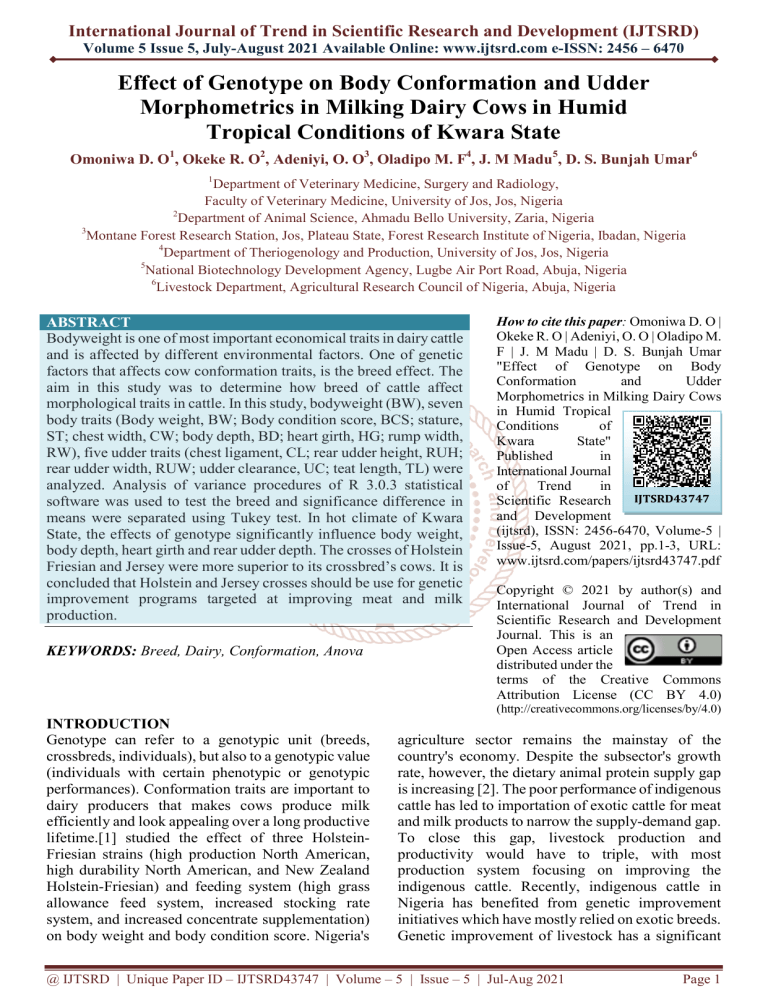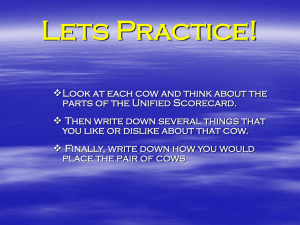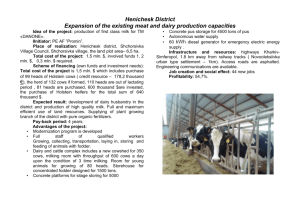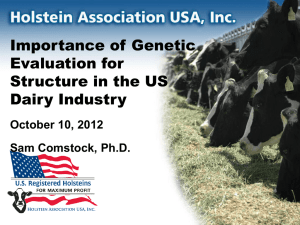
International Journal of Trend in Scientific Research and Development (IJTSRD) Volume 5 Issue 5, July-August 2021 Available Online: www.ijtsrd.com e-ISSN: 2456 – 6470 Effect of Genotype on Body Conformation and Udder Morphometrics in Milking Dairy Cows in Humid Tropical Conditions of Kwara State Omoniwa D. O1, Okeke R. O2, Adeniyi, O. O3, Oladipo M. F4, J. M Madu5, D. S. Bunjah Umar6 1 Department of Veterinary Medicine, Surgery and Radiology, Faculty of Veterinary Medicine, University of Jos, Jos, Nigeria 2 Department of Animal Science, Ahmadu Bello University, Zaria, Nigeria 3 Montane Forest Research Station, Jos, Plateau State, Forest Research Institute of Nigeria, Ibadan, Nigeria 4 Department of Theriogenology and Production, University of Jos, Jos, Nigeria 5 National Biotechnology Development Agency, Lugbe Air Port Road, Abuja, Nigeria 6 Livestock Department, Agricultural Research Council of Nigeria, Abuja, Nigeria ABSTRACT Bodyweight is one of most important economical traits in dairy cattle and is affected by different environmental factors. One of genetic factors that affects cow conformation traits, is the breed effect. The aim in this study was to determine how breed of cattle affect morphological traits in cattle. In this study, bodyweight (BW), seven body traits (Body weight, BW; Body condition score, BCS; stature, ST; chest width, CW; body depth, BD; heart girth, HG; rump width, RW), five udder traits (chest ligament, CL; rear udder height, RUH; rear udder width, RUW; udder clearance, UC; teat length, TL) were analyzed. Analysis of variance procedures of R 3.0.3 statistical software was used to test the breed and significance difference in means were separated using Tukey test. In hot climate of Kwara State, the effects of genotype significantly influence body weight, body depth, heart girth and rear udder depth. The crosses of Holstein Friesian and Jersey were more superior to its crossbred’s cows. It is concluded that Holstein and Jersey crosses should be use for genetic improvement programs targeted at improving meat and milk production. KEYWORDS: Breed, Dairy, Conformation, Anova How to cite this paper: Omoniwa D. O | Okeke R. O | Adeniyi, O. O | Oladipo M. F | J. M Madu | D. S. Bunjah Umar "Effect of Genotype on Body Conformation and Udder Morphometrics in Milking Dairy Cows in Humid Tropical Conditions of Kwara State" Published in International Journal of Trend in IJTSRD43747 Scientific Research and Development (ijtsrd), ISSN: 2456-6470, Volume-5 | Issue-5, August 2021, pp.1-3, URL: www.ijtsrd.com/papers/ijtsrd43747.pdf Copyright © 2021 by author(s) and International Journal of Trend in Scientific Research and Development Journal. This is an Open Access article distributed under the terms of the Creative Commons Attribution License (CC BY 4.0) (http://creativecommons.org/licenses/by/4.0) INTRODUCTION Genotype can refer to a genotypic unit (breeds, crossbreds, individuals), but also to a genotypic value (individuals with certain phenotypic or genotypic performances). Conformation traits are important to dairy producers that makes cows produce milk efficiently and look appealing over a long productive lifetime.[1] studied the effect of three HolsteinFriesian strains (high production North American, high durability North American, and New Zealand Holstein-Friesian) and feeding system (high grass allowance feed system, increased stocking rate system, and increased concentrate supplementation) on body weight and body condition score. Nigeria's agriculture sector remains the mainstay of the country's economy. Despite the subsector's growth rate, however, the dietary animal protein supply gap is increasing [2]. The poor performance of indigenous cattle has led to importation of exotic cattle for meat and milk products to narrow the supply-demand gap. To close this gap, livestock production and productivity would have to triple, with most production system focusing on improving the indigenous cattle. Recently, indigenous cattle in Nigeria has benefited from genetic improvement initiatives which have mostly relied on exotic breeds. Genetic improvement of livestock has a significant @ IJTSRD | Unique Paper ID – IJTSRD43747 | Volume – 5 | Issue – 5 | Jul-Aug 2021 Page 1 International Journal of Trend in Scientific Research and Development @ www.ijtsrd.com eISSN: 2456-6470 impact on animal productivity [3]. In the last decade in Nigeria, genetic improvement initiatives in upgrading our indigenous cattle using foreign (exotic) breeds is lacking. Hence, the research is designed to assess the effect of genotype on the conformation and udder morphometrics traits in dairy cows reared in tropical conditions of Kwara State, Nigeria. Materials and methods Kwara State Shonga Dairy Holdings is situated in Edu Local Government (Kwara State, Nigeria). The farm is located in the tropical climate of Nigeria, with pronounced wet and dry seasons and steady high temperatures. Its geographical coordinates are 9° 1' north, 5° 9' East at an altitude 305m. The nearest meteorological station showed maximum rainfall in month of September which drops to zero in December. The rainy season with a duration of about 218 days, starts in April and ends in October [4] Animal Management Shonga Dairy Holdings in Kwara State has both purebred (Holstein Friesian and Jersey) and crossbred cows (Friesian x Bunaji and Jersey x Bunaji). Females were imported as pregnant heifers. According to the farm records, artificial insemination technique was randomly performed for heifers in the temperate country before importation and for cows after parturition (in Nigeria) using doses of frozen purebred bull semen (imported from the U.S.A.) with a restriction to avoid full-sib and sire-daughter inseminations. The breeding plan in the farms of the study permitted practicing pure breeding through artificial insemination. In the 2010, Shonga farm adopted full time natural mating technique using fifteen fowler grade bulls. The cows were grouped into paddocks ranging in size from 1 to 2.5 hectares according to breed, age and stage of lactation. The cows were kept outdoors in paddocks all year round and were fed hay, mainly 'acha', Digitariaexilis, and maize silage in the dry season (October to April). In the wet season (May to September) the animals were allowed to graze rotationally in paddocks sown with Hyparrheniarufa, Digitariaspp, Andropogonguyanus, Stylosanthesgracilis, Bermuda, Rhodes in correlation with other naturally growing grasses of the area among which are Eleusineindica and Penisetumperpurenm. Salt block and water were available to cows on pasture ad-libitum. Results and discussion Least squares means and coefficients of variation in bodyweight and udder conformation traits among genotypes of cows in ShongaDairy Holdings in Kwara State Genotype had significant (P<0.05) effect on bodyweight and conformation traits (Table 1). All the traits were significant across genotypes with the exception of body condition score, chest ligament, chest width, stature, rump and udder clearance, respectively. The CV % had a minimum value of 7.56 % in body depth (BD) and maximum value of 31.45 % in body condition scores (BCS). The results indicated that overall (N=1592) mean for bodyweight (BW) was 517.33 kg; body condition score (BCS) 3.0; central ligament (CL) 4.3 cm; chest width (CW) 23.1cm; body depth (BD) 210.5 cm; stature (ST) 149.9 cm; rump (RP) 13.1 cm; heart girth (HG) 201.7 cm; udder clearance (UC) 42.6 cm; rear udder height (RUH) 35.7 cm; rear udder width (RUW) 13.9 cm and teat length (TL) 5.06 cm. FriesianxBunaji had heavier bodyweight (633.5 kg) and deeper bodydepth (225.8 cm) which differed significantly across the genetic groups. Highest value for heart girth (223.9 cm) was recorded in JerseyxBunaji cows. Rear udder height in Jersey and Holstein dairy cows was similar and higher (35.7 and 41.2 cm) than the other genotypes, respectively. Conformation traits are important to dairy producers that makes cows produce milk efficiently and look appealing over a long productive lifetime. As a result, conformation traits were recorded in many of the modern dairy cattle breeds. In hot climate of Kwara State, the effects of genotype significantly influence body weight, body depth, heart girth and rear udder depth. The crosses of Holstein Friesian and Jersey were more superior to its crossbred’s cows. The observed differences could be due to hybrid vigour. Also, FriesianxBunaji was more superior compared to JerseyxBunaji. This difference might be as a result of the larger body architecture of the Holstein cows as compared to Jersey cows with smaller body size. The mean bodyweight and heart girth of 517.3 kg and 201.7 cm is higher than the value reported by [5](LW = 513.4 kg, HG = 189.36 cm) for Holstein cattle in developed country.[6] documented an average score of 4.94±1.51 in Holstein breed using a nine point scoring scale. [7] reported a score of 4.90±1.26 in Czech Holstein breed. These findings are higher to the findings of current study (3.3±0.06). The differences may be due to species, morphological, environmental and management differences in different agro ecological zones. The purebred Holstein Friesian and Jersey cows had significantly larger udder as compared to their crossbred counterparts. The reduction in distance may be proportional to the significantly smaller stature of the purebred cows in this study. Increased distance from the secretary tissue at the top of the rear udder to the base of the vulva may indicate a weak rear udder attachment. The decreased rear udder attachment @ IJTSRD | Unique Paper ID – IJTSRD43747 | Volume – 5 | Issue – 5 | Jul-Aug 2021 Page 2 International Journal of Trend in Scientific Research and Development @ www.ijtsrd.com eISSN: 2456-6470 height in Holstein Friesian and Jersey sired Bunaji is a larger dairy breed while Jersey breed architecture cows may be considered an unfavorable change and was developed to be smaller. The high coefficient of may contribute to culling or increased mastitis. The variation in some of the traits observed for the body decreased rear udder height may be a dam effect and udder conformation traits may be due to the rather than breed of sire effect, as dams of crossbreds inherent variability present in the genotype of cows had significantly decreased rear udder heights used in this study. Wider variability observed in teat compared to dams of purebreds. Holstein Friesian had length amongst the udder conformation traits is a a larger body depth than Jersey cows which was reflection of the trait to machine milking adaptation. borne primarily out of the fact that Holstein Friesian Table 1: Least squares means (±standard error) and coefficient of variation for body and udder conformation traits among different genetic groups of cows in Shonga Dairy Holdings in Kwara State Holstein FRxBJ Jersey JxBJ Overall CV Conformation Traits Friesian SEM (n=360) (n=510) (n=355) (n=1592) % (n=367) Body weight (kg) 610.2±13.5b 633.5±14.6a 522.24±13.94c 531.3±10.49c 517.3±5.35 18.21 18.84 BCS (1-5) 2.9±0.05 2.8±0.06 3.3±0.12 3.2±0.15 3.0±0.06 31.45 0.45 Central ligament (cm) 4.4±0.07 4.4±0.13 4.3±0.04 4.3±0.05 4.3±0.04 15.54 0.34 Chest width (cm) 43.3±0.38 43.6±0.40 43.4±0.17 41.9±0.15 42.1±0.15 11.71 1.32 Body depth(cm) 223.3±0.15a 225.8±0.54a 191.2±0.99c 203.6±0.68b 210.5±0.90 7.56 3.03 Stature (cm) 145.9±1.26 152.6±8.23 152.5±1.53 149.9±1.60 149.9±1.80 21.12 15.85 Rump (cm) 14.0±0.15 12.7±0.27 12.7±0.07 12.7±0.09 13.1±0.08 11.29 0.68 b c b a Heart girth (cm) 198.0±1.54 176.4±1.40 207.6±1.11 223.9±0.51 201.7±1.10 9.56 5.68 Udder clearance (cm) 41.2±0.91 43.1±1.37 44.1±0.51 41.9±0.70 42.6±0.45 18.45 3.90 Rear Udder height (cm) 41.8±1.05a 28.2±0.06b 35.7±0.60a 28.9±1.27b 35.7±0.52 25.44 3.54 Rear Udder width (cm) 15.1±0.05a 15.0±0.04a 12.7±0.07b 12.8±0.08b 13.9±0.07 9.33 0.58 Teat length (cm) 4.7±0.08 5.1±0.10 5.2±0.02 5.2±0.06 5.06±0.04 14.53 0.36 abc Means of the same trait across genetic groups with different superscripts differ significantly (P<0.05); BCSBody condition score; CV-Coefficient of variation; SEM-Standard error of mean; FRxBJ-FriesianXBunaji; JxBJ-JerseyxBunaji Conclusions Genotype significantly influence body weight, body depth, heart girth and rear udder depth. Holstein and FriesianXBunaji crosses had the best conformation traits under the humid conditions of Kwara State hence they can be used to upgrade Nigerian indigenous during a genetic improvement programmes targeted towards upgrading the meat type cattle. References [1] McCarthy, S., Berry, D.P., Dillon, P., Rath, M. and Horan, B. (2007). Influence of HolsteinFriesian strain and feed system on bodyweight and body condition score lactation profiles. Journal of Dairy Science,90: 1859–1869 [2] Oludayo Michael Akinsola, IshayaBawaAtang, AdekolaOmololuAtanda, Louis Ugwu, DanladiShuaibuBunjah, Dorcas John Jirgi, and MuizzatOnozasi Bello Genetic Parameter Estimates for Milk and Conformation Traits of Multi-genotype Cattle. Asian Journal of Advances in Agricultural Research, 2018, 5(3): 1-8. [3] Abejide, O (2018). Across country dairy breeding strategies in Sub-Saharan African. A PhD dissertation submitted to the University of Edinburgh, UK. Pp 226. [4] Climate-Data (2015): Climate-Data.org. Retrieved December 12, 2015, from http://en.climate-data.org/location/402824. [5] Ozkaya, S. and Bozkurt, Y. (2009). The accuracy of prediction of body weight from body measurements in beef cattle. Archive Tierz.52: 371–377. [6] Koenen, E.P.C., Veerkamp R.F., Dobbelaar, P. and De Jong, G. (2001). Genetic analysis of body condition score of lactating Dutch Holstein and Red-and-White heifers. Journal of Dairy Science, 84: 1265-1270. [7] Zavadilová, L., Němcová, E., Štípková, M. and Bouška, J. (2009). Relationships between longevity and conformation traits in Czech Fleckvieh cows. Czech Journal of Animal Science, 54: 387-394. @ IJTSRD | Unique Paper ID – IJTSRD43747 | Volume – 5 | Issue – 5 | Jul-Aug 2021 Page 3





